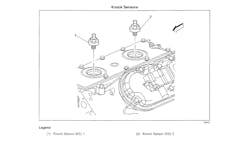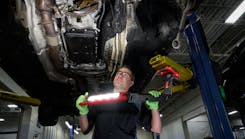Case Study: Chevy truck throws DTCs P0327 and P0332
Vehicle: 2001 Chevy K 1500, 4WD, V8-5.3L, VIN T, Automatic Transmission/Transaxle
Mileage: 225,889
Problem: The owner brought his truck in because the malfunction indicator light (MIL) was on. Engine performance seemed normal.
Case details: When the technician first connected the scan tool, he found DTC P0327 - Front Knock Sensor Circuit Low.
Using the scan tool, he found no response from the front knock sensor, so he removed the intake manifold to access both sensors. He found excessive corrosion on both knock sensors and the wiring harness.
The technician recommended replacing both knock sensors and the wiring harness with OEM parts.
After replacing both sensors and the wiring harness and reinstalling the intake manifold, he cleared the DTC and restarted the engine. The MIL came right back on. This time there were two DTCs:
- P0327 - Front Knock Sensor Circuit Low
- P0332 - Rear Knock Sensor Circuit Low
He thought there may be a problem with the harness, so the technician removed the intake manifold again. He tested the harness and the knock sensors. There were no issues with the harness and the resistance on both sensors was 103kohms, which was within specs. At this point, the technician called ALLDATA Tech-Assist for some guidance.
The Tech-Assist consultant suggested load testing the harness. It was okay. He also advised scope testing both sensors while tapping on the engine near the sensors with something metallic. There was no response from either knock sensor. The consultant then asked if the engine had a good ground. The technician checked and all ground points were good.
The only thing left was to order two more OEM sensors. The new sensors did not respond either. The technician tried a different scope and two more OEM sensors and got the same results.
This is where the story gets interesting. After going through a total of six OEM knock sensors, the technician decided to install a couple of aftermarket sensors. Both sensors responded perfectly during the scope test. The tech reinstalled the intake manifold, cleared the DTCs, started the engine, and held his breath. The MIL did not come back on. A lengthy test drive verified the problem was finally fixed!
Reprinted with permission from ALLDATA.




